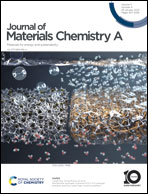A compounding strategy to boost the transduction coefficient in KNN-based piezoelectric composite ceramics for ultrasonic energy harvesting†
Abstract
Piezoelectric ultrasonic energy harvesters (PUEHs), an emerging technology that utilizes ultrasonic excitation, have been integrated into various wireless power systems for functional applications. However, most of the current PUEHs use lead-based piezoelectric materials that are harmful to human health and the environment. Additionally, the energy transduction coefficient (d33 × g33) is a key factor in obtaining high-performance PUEHs, yet it is difficult to obtain both a high piezoelectric coefficient (d33) and high piezoelectric voltage constant (g33). Herein, we present a composite strategy of effectively compounding two precursor powders of (K,Na)NbO3-based ceramics to modulate the piezoelectric coefficient and dielectric constant, thereby boosting d33 × g33 for optimizing ultrasonic energy harvesting. Benefiting from the evolution of overall polarization fluctuations in the composite system, the lead-free composites exhibit an enhanced d33 × g33 value of 10 260 × 10−15 m2 N−1, superior to those of most lead-free ceramics and even some lead-based ones. The composites were further manufactured into PUEHs, with ultrasound-induced adjustable outputs of up to ∼16 Vpp, a voltage efficiency of ∼10%, and an instantaneous power of ∼42 mW. The electricity generated by the PUEHs can directly light up a commercial LED array and can be stored in capacitors, showing great potential for being wireless power sources for next-generation micro-electronic equipment.

- This article is part of the themed collection: 2023 Journal of Materials Chemistry A HOT Papers


 Please wait while we load your content...
Please wait while we load your content...